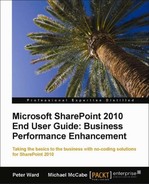The My Profile page is the default landing page for your personal site, for you and for others accessing your site. This page provides an abundance of information and gives you the ability to manage details about yourself, colleagues, and memberships.
In addition, the content and information that is displayed can be managed using views. A few out of the box views are as follows:
- Everyone: This view will enable every user that has access to your SharePoint site to see your content
- Only Me: This view will only enable you (the site owner) to see your content
- My Colleagues: This view will enable every user that you have listed in your My Colleagues list to see your content
- My Manager: This view will only enable your manager (pulled from Active Directory) to see your content
- My Team: This view will enable specific users that you have identified in your My Colleagues list to see your content

These settings provide useful personalization of information to certain groups of workers and team members who are more active than others in their day-to-day work.
Note
We encourage you to apply settings that you think are most beneficial to you and your team. However, if you work in a large company and everyone can see your cell phone numbers, you run the risk of being inundated with requests from co-workers because the SharePoint site will probably be the tool of choice for workers to find someone with a specific skill set and their corresponding contact number within the company.
The My Profile page is divided into the following six tabs:
- Overview
- Organization
- Content
- Tags and Notes
- Colleagues
- Memberships

You navigate through the different portions of your personal site by clicking on these tabs:
- Overview: This tab displays general information about you via a few web parts on the page (refer to the following screenshot). The Ask Me About web part allows you to list topics that you feel you are knowledgeable about and where you should be involved so that other people know to come to you for assistance on the subject matter. The more detailed this is, the more status and credibility within an organization you will have as your team, colleagues, and co-workers will understand your role and what activities you are accountable for in this role.
- The Recent Activities web part lists relevant social actions that you have performed throughout the environment, such as the creation of tags and notes. The Note Board web part allows you and others to share notes and comments. The My Organization Chart shows where you are in relation to the organizational hierarchy. The In Common with You web part shows common traits that you share with users accessing your personal site. This information propagates other colleagues' My Site news feeds.
- Organization: This particular tab displays an interactive organizational chart using the Microsoft Silverlight plugin for your web browser. This chart is constructed using SharePoint profile manager relationships, and allows you to see a user's position in the organizational hierarchy. The actual data is pulled from your organization's Active Directory during the user profile import. You can use this chart to move up and down the hierarchy to find information about any user.

- Content: This tab displays all of the lists, libraries, and blog posts that you manage through your My Content page.

The My Site design does not have a link to return you to a team site within the site collection. We recommend that you add a My Links web part to your My Content page on your My Site and add in a link to the site collection (home page).
- Tags and Notes: This tab displays the tags and notes that you have created throughout the environment using SharePoint's social tagging mechanisms way. Social tagging of content in SharePoint 2010 consists of two links on all SharePoint pages: I Like It and Tags and Notes. These mechanisms enable you to identify content important to you and add personal descriptions of the identified content. In your personal site, these tags and notes are aggregated so that you can filter and sort through them in a structured, effective manner.
Tip
One way to think of Tags and Notes is as an online equivalent of Post-It notes on a bulletin board or refrigerator. If you are the kind of person who is intuitive and likes to have information neatly categorized, this SharePoint functionality is ideal for cataloguing content.
- Colleagues: This tab lists all of your colleagues. It enables you to define your relationships with colleagues, to manage your team members, to delete colleagues, and so on. If you need to find out more information about a colleague, just click on their name. You will then open up the shared component of their personal site.
- Memberships: This tab lists all of the SharePoint groups that you are a member of. If you are viewing someone else's memberships on their My Site, the memberships in common will be displayed. From this page, you can manage your group information. This is a useful feature if you are taking over the role of another user; instead of asking them which groups they are a member of, you can look at this page.
The last two points, colleagues and memberships, are very useful during an on-boarding process of a new colleague to the team because they can very quickly see who the team members are and the groups to which co-workers belong.
